C++提高编程
本阶段主要针对C++泛型编程和STL技术做详细讲解,探讨C++更深层的使用
一.模板
1.1 模板的概念
模板就是建立通用的模具,大大提高复用性
模板的特点:
模板不可以直接使用,它只是一个框架
模板的通用并不是万能的
1.2 函数模板
C++另一种编程思想称为 泛型编程 ,主要利用的技术就是模板
C++提供两种模板机制:函数模板和类模板
1.2.1 函数模板语法
函数模板作用:
建立一个通用函数,其函数返回值类型和形参类型可以不具体制定,用一个虚拟的类型来代表。
语法:
template<typename T>
解释:
template — 声明创建模板
typename — 表面其后面的符号是一种数据类型,可以用class代替
T — 通用的数据类型,名称可以替换,通常为大写字母
#include<iostream>
using namespace std;
//函数模板
//两个整形交换
void swapInt(int& a, int& b)
{
int temp = a;
a = b;
b = temp;
}
//交换两个浮点型的函数
void swapDouble(double& a, double& b)
{
double temp = a;
a = b;
b = temp;
}
//函数模板
template<typename T> //声明一个模板,告诉编译器后面代码中紧跟着的T不要报错 T不是一个通用数据类型
void mySwap(T& a, T& b)
{
T temp = a;
a = b;
b = temp;
}
void test01()
{
int a = 10;
int b = 20;
//swapInt(a, b);
//利用函数模板进行交换
//两种方式使用函数模板
//1.自动类型推导
//mySwap(a, b);
//显示指定类型
mySwap<int>(a, b);
cout << "a = " << a << endl;
cout << "b = " << b << endl;
/*double c = 1.1;
double d = 2.2;
swapDouble(c, d);
cout << "c = " << c << endl;
cout << "d = " << d << endl;*/
}
int main()
{
test01();
system("pause");
return 0;
}总结:
函数模板利用关键字 template
使用函数模板有两种方式:自动类型推导、显示指定类型
模板的目的是为了提高复用性,将类型参数化
1.2.2 函数模板注意事项
注意事项:
自动类型推导,必须推导出一致的数据类型T,才可以使用
模板必须要确定出T的数据类型,才可以使用
#include<iostream>
using namespace std;
//函数模板注意事项
template<class T> //typename可以替换为class
void mySwap(T& a, T& b)
{
T temp = a;
a = b;
b = temp;
}
//1.自动类型推导,必须推出一致的数据类型T才可以使用
void test01()
{
int a = 10;
int b = 20;
char c = 'c';
//mySwap(a, b); 正确
//mySwap(a, c); 错误,推导不出一致的T类型
cout << "a = " << a << endl;
cout << "b = " << b << endl;
}
//2.模板必须要确定出T的数据类型,才可以使用
template<class T>
void func()
{
cout << "func 调用" << endl;
}
void test02()
{
func<int>();
}
int main()
{
//test01();
test02();
system("pause");
return 0;
}总结:
使用模板时必须确定出通用数据类型T,并且能够推导出一致的类型
1.2.3 函数模板案例
案例描述:
利用函数模板封装一个排序的函数,可以对不同数据类型数组进行排序
排序规则从大到小,排序算法为选择排序
分别利用char数组和int数组进行测试
#include<iostream>
using namespace std;
//实现一个通用的对数组进行排序的函数
//规则 从大到小
//算法 选择
//测试 char 数组, int 数组
//交换函数模板
template<class T>
void mySwap(T& a, T& b)
{
T temp = a;
a = b;
b = temp;
}
//排序算法
template<class T>
void mySort(T arr[],int len)
{
for (int i = 0; i < len; i++)
{
int max = i; //认定最大值得下标
for (int j = i+1;j < len; j++)
{
//认定的最大值比遍历出的数值要小,说明j下标的元素才是正真的最大值
if (arr[max] < arr[j])
{
max = j; //更新最大值坐标
}
}
if (max != i)
{
//交换max和i元素
mySwap(arr[max], arr[i]);
}
}
}
//提供打印数组的模板
template<class T>
void printArray(T arr[], int len)
{
for (int i = 0; i < len; i++)
{
cout << arr[i] << " ";
}
cout << endl;
}
void test01()
{
//测试char数组
char charArr[] = "badcf";
int num = sizeof(charArr) / sizeof(char);
mySort(charArr, num);
printArray(charArr, num);
}
void test02()
{
//测试int数组
int intArr[] = { 7,5,6,9,1 };
int num = sizeof(intArr) / sizeof(int);
mySort(intArr, num);
printArray(intArr, num);
}
int main()
{
//test01();
test02();
system("pause");
return 0;
}总结:模板可以提高代码复用,需要熟练掌握
1.2.4 普通函数与函数模板的区别
普通函数与函数模板区别:
普通函数调用时可以发生自动类型转换(隐式类型转换)
函数模板调用时,如果利用自动类型推导,不会发生隐式类型转换
如果利用显示指定类型的方式,可以发生隐式类型转换
#include<iostream>
using namespace std;
//普通函数与函数模板的区别
//1.普通函数调用时可以发生隐式类型转换
//2.函数模板 用自动类型推导,不可以发生隐式类型转换
//3.函数模板,用显示指定类型,可以发生隐式类型转换
//普通函数
int myAdd01(int a, int b)
{
return a + b;
}
//函数模板
template<class T>
T myAdd02(T a,T b)
{
return a + b;
}
void test01()
{
int a = 10;
int b = 20;
char c = 'c'; //a 97 c 99
cout << myAdd01(a, c) << endl;
//自动类型推导 不会发生隐式类型转换
//cout << myAdd02(a, c) << endl;
//显示指定类型 会发生隐式类型转换
cout << myAdd02<int>(a, c) << endl;
}
int main()
{
test01();
system("pause");
return 0;
}总结:建议使用显示指定类型的方式,调用函数模板,因为可以自己确定通用类型T
1.2.5 普通函数与函数模板的调用规则
调用规则如下:
如果函数模板和普通函数都可以实现,优先调用普通函数
可以通过空模板参数列表来强制调用函数模板
函数模板也可以发生重载
如果函数模板可以产生更好的匹配,优先调用函数模板
#include<iostream>
using namespace std;
//普通函数与函数模板的调用规则
//1.如果函数模板和普通函数都可调用,优先调用普通函数
//2.可以通过空模板的参数列表的方式强制调用函数模板
//3.函数模板可以发生函数重载
//4.如果函数模板可以产生更好的匹配,优先要用函数模板
void myPrint(int a, int b)
{
cout << "调用的普通函数" << endl;
}
template<class T>
void myPrint(T a, T b)
{
cout << "调用的模板" << endl;
}
template<class T>
void myPrint(T a, T b, T c)
{
cout << "调用重载的模板" << endl;
}
void test01()
{
int a = 10;
int b = 20;
//myPrint(a, b);
//通过空模板的参数列表,强制调用函数模板
//myPrint<>(a, b);
//myPrint<>(a, b, 100);
//如果函数模板产生更好的匹配,优先调用函数模板
char c1 = 'a';
char c2 = 'b';
myPrint(c1, c2);
}
int main()
{
test01();
system("pause");
return 0;
}总结:既然提供了函数模板,最好就不要提供普通函数,否则容易出现二义性
1.2.6 模板的局限性
局限性:
模板的通用性并不是万能的
#include<iostream>
using namespace std;
#include<string>
//模板局限性
//模板不是万能的,有些特定数据类型,需要用具体化方式做特殊实现
class Person
{
public:
Person(string name, int age)
{
this->m_Name = name;
this->m_Age = age;
}
//姓名
string m_Name;
//年龄
int m_Age;
};
//对比两个数据是否想的的函数
template<class T>
bool myComper(T& a, T& b)
{
if (a == b)
{
return true;
}
else
{
return false;
}
}
//利用具体化的Person的版本实现代码,具体化优先调用
template<>bool myComper(Person& p1, Person& p2)
{
if (p1.m_Name == p2.m_Name && p1.m_Age == p2.m_Age)
{
return true;
}
else
{
return false;
}
}
void test01()
{
int a = 10;
int b = 20;
bool ret = myComper(a, b);
if (ret)
{
cout << "a == b" << endl;
}
else
{
cout << "a != b" << endl;
}
}
void test02()
{
Person p1("Tom", 10);
Person p2("Tom", 11);
bool ret = myComper(p1, p2);
if (ret)
{
cout << "p1 == p2" << endl;
}
else
{
cout << "p1 != p2" << endl;
}
}
int main()
{
//test01();
test02();
system("pause");
return 0;
}利用具体化的模板,可以解决自定义类型的通用化
学习模板并不是为了写模板,而是在STL能够运用系统提供的模板
1.3 类模板
1.3.1 类模板语法
类模板作用:
建立一个通用类,类中的成员 数据类型可以不具体制定,用一个虚拟的类型来代表。
#include<iostream>
using namespace std;
#include<string>
//类模板
template<class NameType,class AgeType>
class Person
{
public:
Person(NameType name, AgeType age)
{
this->m_Name = name;
this->m_Age = age;
}
void showPerson()
{
cout << "name = " << this->m_Name << "age = " << this->m_Age << endl;
}
NameType m_Name;
AgeType m_Age;
};
void test01()
{
Person<string, int>p1("孙悟空", 999);
p1.showPerson();
}
int main()
{
test01();
system("pause");
return 0;
}总结:类模板和函数模板语法相似,在声明模板template后面加类,此类称为类模板
1.3.2 类模板与函数模板区别
类模板与函数模板区别主要有两点:
类模板没有自动类型推导的使用方式
类模板在模板参数列表中可以有默认参数
#include<iostream>
using namespace std;
#include<string>
//类模板与函数模板的区别
template<class NameType,class AgeType = int>
class Person
{
public:
Person(NameType name, AgeType age)
{
this->m_Name = name;
this->m_Age = age;
}
void showPerson()
{
cout << "name:" << this->m_Name << "age:" << this->m_Age << endl;
}
NameType m_Name;
AgeType m_Age;
};
//1.类模板没有自动类型推导的使用方式
void test01()
{
//Person p("孙悟空", 1000); //错误的,无法用自动类型推导
Person<string, int>p("孙悟空", 1000);
p.showPerson();
}
//2.类模板在模板参数列表中可以有默认参数
void test02()
{
Person<string>p("猪八戒", 999);
p.showPerson();
}
int main()
{
//test01();
test02();
system("pause");
return 0;
}总结:
类模板使用只能用显示指定类型方式
类模板中的模板参数列表可以有默认参数
1.3.3 类模板中成员函数创建时机
类模板中成员函数和普通类中成员函数创建时机是有区别的:
普通类中的成员函数一开始就可以创建
类模板中的成员函数在调用时才创建
#include<iostream>
using namespace std;
//类模板中成员函数创建时机
//类模板中成员函数在调用时才去创建
class Person1
{
public:
void showPerson1()
{
cout << "Person1 show" << endl;
}
};
class Person2
{
public:
void showPerson2()
{
cout << "Person2 show" << endl;
}
};
template<class T>
class MyClass
{
public:
T obj;
//类模板中成员函数
void func1()
{
obj.showPerson1();
}
void func2()
{
obj.showPerson2();
}
};
void test01()
{
MyClass<Person1>m;
m.func1();
//m.func2();
}
int main()
{
test01();
system("pause");
return 0;
}总结:类模板中的成员函数并不是一开始就创建的,在调用时才去创建
1.3.4 类模板对象做函数参数
学习目标:
类模板实例化出的对象,向函数传参的方式
一共有三种传入方式:
指定传入的类型 — 直接显示对象的数据类型
参数模板化 — 将对象中的参数变为模板进行传递
整个类模板化 — 将这个对象类型 模板化进行传递
#include<iostream>
using namespace std;
#include<string>
//类模板的对象做函数参数
template<class T1, class T2>
class Person
{
public:
Person(T1 name, T2 age)
{
this->m_Name = name;
this->m_Age = age;
}
void showPerson()
{
cout << "姓名:" << this->m_Name << "年龄:" << this->m_Age << endl;
}
T1 m_Name;
T2 m_Age;
};
//1.指定传入类型
void printPerson1(Person<string,int>&p)
{
p.showPerson();
}
void test01()
{
Person<string, int>p("孙悟空", 100);
printPerson1(p);
}
//2.参数模板化
template<class T1,class T2>
void printPerson2(Person<T1,T2>&p)
{
p.showPerson();
cout << "T1的类型为:" << typeid(T1).name() << endl;
cout << "T2的类型为:" << typeid(T2).name() << endl;
}
void test02()
{
Person<string, int>p("猪八戒", 90);
printPerson2(p);
}
//3.整个类模板化
template<class T>
void printPerson3(T &p)
{
p.showPerson();
cout << "T的数据类型为:" << typeid(T).name() << endl;
}
void test03()
{
Person<string, int>p("唐僧", 30);
printPerson3(p);
}
int main()
{
//test01();
//test02();
test03();
system("pause");
return 0;
}总结:
通过类模板创建的对象,可以有三种方式向函数中进行传参
使用比较广泛是第一种:指定传入的类型
1.3.5 类模板与继承
当类模板碰到继承时,需要注意一下几点:
当子类继承的父类是一个类模板时,子类在声明的时候,要指定出父类中T的类型
如果不指定,编译器无法给子类分配内存
如果想灵活指定出父类中T的类型,子类也需变为类模板
#include<iostream>
using namespace std;
//类模板与继承
template<class T>
class Base
{
T m;
};
//class Son :public Base //错误必须知道父类中的T的数据类型,才能继承子类
//{
//
//};
class Son :public Base<int>
{
};
void test01()
{
Son s1;
}
//如果想灵活指定父类中T类型,子类也需要变类模板
template<class T1, class T2>
class Son2 :public Base<T2>
{
public:
Son2()
{
cout << "T1的类型为:" << typeid(T1).name() << endl;
cout << "T2的类型为:" << typeid(T2).name() << endl;
}
T1 obj;
};
void test02()
{
Son2<int, char>s2;
}
int main()
{
//test01();
test02();
system("pause");
return 0;
}总结:如果父类是类模板,子类需要指定出父类中T的数据类型
1.3.6 类模板成员函数类外实现
学习目标:能够掌握类模板中的成员函数类外实现
#include<iostream>
using namespace std;
#include<string>
//类模板成员函数类外实现
template<class T1, class T2>
class Person
{
public:
Person(T1 name, T2 age);
/*{
this->m_Name = name;
this->m_Age = age;
}*/
void showPerson();
/*{
cout << "姓名:" << this->m_Name << "年龄:" << this->m_Age << endl;
}*/
T1 m_Name;
T2 m_Age;
};
//构造函数的类外实现
template<class T1, class T2>
Person<T1, T2>::Person(T1 name, T2 age)
{
this->m_Name = name;
this->m_Age = age;
}
//成员函数类外实现
template<class T1, class T2>
void Person<T1, T2>::showPerson()
{
cout << "姓名:" << this->m_Name << "年龄:" << this->m_Age << endl;
}
void test01()
{
Person<string, int>p("Tom", 20);
p.showPerson();
}
int main()
{
test01();
system("pause");
return 0;
}总结:类模板中成员函数类外实现时,需要加上模板参数列表
1.3.7 类模板分文件编写
学习目标:
掌握类模板成员函数分文件编写产生的问题以及解决方式
问题:
类模板中成员函数创建时机是在调用阶段,导致分文件编写时链接不到
解决:
解决方式1:直接包含.cpp源文件
解决方式2:将声明和实现写到同一个文件中,并更改后缀名为.hpp,hpp是约定的名称,并不是强制
源cpp
#include<iostream>
using namespace std;
//#include<string>
//第一种解决方式,直接包含 源文件
//#include"person.cpp"
//第二种解决方式,将.h个.cpp中的内容写到一起,将后缀名改为.hpp文件
#include"person.hpp"
//类模板分文件编写问题以及解决
//template<class T1,class T2>
//class Person
//{
//public:
// Person(T1 name, T2 age);
//
// void showPerson();
//
// T1 m_Name;
// T2 m_Age;
//
//};
//template<class T1,class T2>
//Person<T1, T2>::Person(T1 name, T2 age)
//{
// this->m_Name = name;
// this->m_Age = age;
//}
//
//template<class T1, class T2>
//void Person<T1, T2>::showPerson()
//{
// cout << "姓名:" << this->m_Name << "年龄:" << this->m_Age << endl;
//
//}
void test01()
{
Person<string, int>p("Jerry", 18);
p.showPerson();
}
int main()
{
test01();
system("pause");
return 0;
}person.hpp
#pragma once
#include<iostream>
using namespace std;
#include<string>
template<class T1, class T2>
class Person
{
public:
Person(T1 name, T2 age);
void showPerson();
T1 m_Name;
T2 m_Age;
};
//#include"person.h"
template<class T1, class T2>
Person<T1, T2>::Person(T1 name, T2 age)
{
this->m_Name = name;
this->m_Age = age;
}
template<class T1, class T2>
void Person<T1, T2>::showPerson()
{
cout << "姓名:" << this->m_Name << "年龄:" << this->m_Age << endl;
}总结:主流的解决方式是第二种,将类模板成员函数写到一起,并将后缀名改为.hpp
1.3.8 类模板与友元
学习目标:
掌握类模板配合友元函数的类内和类外实现
全局函数类内实现 - 直接在类内声明友元即可
全局函数类外实现 - 需要提前让编译器知道全局函数的存在
#include<iostream>
using namespace std;
#include<string>
//通过全局函数打印Person信息
template<class T1,class T2>
class Person;
//类外实现
template<class T1, class T2>
void printPerson2(Person<T1, T2>p)
{
cout << "类外实现--姓名:" << p.m_Name << "年龄:" << p.m_Age << endl;
}
template<class T1,class T2>
class Person
{
//全局函数 类内实现
friend void printPerson(Person<T1,T2>p)
{
cout << "姓名:" << p.m_Name << "年龄:" << p.m_Age << endl;
}
//全局函数 类外实现
//加空模板参数列表
//如果全局函数 是类外实现,需要让编译器提前知道这个函数的存在
friend void printPerson2<>(Person<T1, T2>p);
public:
Person(T1 name, T2 age)
{
this->m_Name = name;
this->m_Age = age;
}
private:
T1 m_Name;
T2 m_Age;
};
//1.全局函数在类内实现
void test01()
{
Person<string, int>p("Tom", 20);
printPerson(p);
}
//2.全局函数在类外实现
void test02()
{
Person<string, int>p("Jerry", 20);
printPerson2(p);
}
int main()
{
//test01();
test02();
system("pause");
return 0;
}总结:建议全局函数做类内实现,用法简单,而且编译器可以直接识别
1.3.9 类模板案例
案例描述: 实现一个通用的数组类,要求如下:
可以对内置数据类型以及自定义数据类型的数据进行存储
将数组中的数据存储到堆区
构造函数中可以传入数组的容量
提供对应的拷贝构造函数以及operator=防止浅拷贝问题
提供尾插法和尾删法对数组中的数据进行增加和删除
可以通过下标的方式访问数组中的元素
可以获取数组中当前元素个数和数组的容量
源.cpp
#include<iostream>
using namespace std;
#include"MyArray.hpp"
#include<string>
void printIntArray(MyArray<int>& arr)
{
for (int i = 0; i < arr.getSize(); i++)
{
cout << arr[i] << endl;
}
}
void test01()
{
MyArray<int> arr1(5);
for (int i = 0; i < 5; i++)
{
//利用尾插法向数组中插入数据
arr1.Push_Back(i);
}
cout << "arr1的打印输出为:" << endl;
printIntArray(arr1);
cout << "arr1的容量为:" << arr1.getCapacity() << endl;
cout << "arr1的大小为:" << arr1.getSize() << endl;
MyArray<int> arr2(arr1);
cout << "arr2的打印输出为:" << endl;
printIntArray(arr2);
//尾删
arr2.pop_Back();
cout << "arr2尾删后" << endl;
cout << "arr2的容量为:" << arr2.getCapacity() << endl;
cout << "arr2的大小为:" << arr2.getSize() << endl;
//MyArray<int>arr3(100);
//arr3 = arr1;
}
//测试自定义数据类型
class Person
{
public:
Person()
{
}
Person(string name, int age)
{
this->m_Name = name;
this->m_Age = age;
}
string m_Name;
int m_Age;
};
void printPersonArray(MyArray<Person>& arr)
{
for (int i = 0; i < arr.getSize(); i++)
{
cout << "姓名:" << arr[i].m_Name << "年龄:" << arr[i].m_Age << endl;
}
}
void test02()
{
MyArray<Person>arr(10);
Person p1("孙悟空", 999);
Person p2("韩信", 30);
Person p3("妲己", 20);
Person p4("赵云", 25);
Person p5("安琪拉", 27);
//将数据插入到数组中
arr.Push_Back(p1);
arr.Push_Back(p2);
arr.Push_Back(p3);
arr.Push_Back(p4);
arr.Push_Back(p5);
//打印数组
printPersonArray(arr);
//输出容量
cout << "arr容量为:" << arr.getCapacity() << endl;
//输出大小
cout << "arr大小为:" << arr.getSize() << endl;
}
int main()
{
//test01();
test02();
system("pause");
return 0;
}MyArray.hpp
//自己通用的数组类
#pragma once
#include<iostream>
using namespace std;
template<class T>
class MyArray
{
public:
//有参构造 参数 容量
MyArray(int capacity)
{
//cout << "MyArray有参构造调用" << endl;
this->m_Capacity = capacity;
this->m_Size = 0;
this->pAddress = new T[this->m_Capacity];
}
//拷贝构造
MyArray(const MyArray& arr)
{
//cout << "MyArray拷贝造调用" << endl;
this->m_Capacity = arr.m_Capacity;
this->m_Size = arr.m_Size;
//this->pAddress = arr.pAddress;
//深拷贝
this->pAddress = new T[arr.m_Capacity];
//将arr中的数据都拷贝过来
for (int i = 0; i < this->m_Size; i++)
{
this->pAddress[i] = arr.pAddress[i];
}
}
//operator= 防止浅拷贝问题 a = b = c
MyArray& operator=(const MyArray& arr)
{
//cout << "MyArray的operator = 构造调用" << endl;
//先判断原来堆区是否有数据,如果有先释放
if (this->pAddress != NULL)
{
delete[] this->pAddress;
this->pAddress = NULL;
this->m_Capacity = 0;
this->m_Size = 0;
}
//深拷贝
this->m_Capacity = arr.m_Capacity;
this->m_Size = arr.m_Size;
this->pAddress = new T[arr.m_Capacity];
for (int i = 0; i < this->m_Size; i++)
{
this->pAddress[i] = arr.pAddress[i];
}
return *this;
}
//尾插法
void Push_Back(const T& val)
{
//判断容量是否等于大小
if (this->m_Capacity == this->m_Size)
{
return;
}
this->pAddress[this->m_Size] = val;
this->m_Size++; //更新数组大小
}
//尾删法
void pop_Back()
{
//让用户访问不到最后一个元素,即为尾删,逻辑删除
if (this->m_Size == 0)
{
return;
}
this->m_Size--;
}
//用户通过下标方式访问数组中的元素
T& operator[](int index)
{
return this->pAddress[index];
}
//返回数组的容量
int getCapacity()
{
return this->m_Capacity;
}
//返回数组的大小
int getSize()
{
return this->m_Size;
}
//析构函数
~MyArray()
{
if (this->pAddress != NULL)
{
//cout << "MyArray析构调用" << endl;
delete[]this->pAddress;
this->pAddress = NULL;
}
}
private:
T* pAddress; //指针指向堆区开辟的真实数组
int m_Capacity; //数组容量
int m_Size; //数组大小
};
二. STL初识
2.1 STL的诞生
长久以来,软件界一直希望建立一种可重复利用的东西
C++的面向对象和泛型编程思想,目的就是复用性的提升
大多情况下,数据结构和算法都未能有一套标准,导致被迫从事大量重复工作
为了建立数据结构和算法的一套标准,诞生了STL
2.2 STL基本概念
STL(Standard Template Library,标准模板库)
STL 从广义上分为: 容器(container) 算法(algorithm) 迭代器(iterator)
容器和算法之间通过迭代器进行无缝连接。
STL 几乎所有的代码都采用了模板类或者模板函数
2.3 STL六大组件
STL大体分为六大组件,分别是:容器、算法、迭代器、仿函数、适配器(配接器)、空间配置器
容器:各种数据结构,如vector、list、deque、set、map等,用来存放数据。
算法:各种常用的算法,如sort、find、copy、for_each等
迭代器:扮演了容器与算法之间的胶合剂。
仿函数:行为类似函数,可作为算法的某种策略。
适配器:一种用来修饰容器或者仿函数或迭代器接口的东西。
空间配置器:负责空间的配置与管理。
2.4 STL中容器、算法、迭代器
**容器:**置物之所也
STL容器就是将运用最广泛的一些数据结构实现出来
常用的数据结构:数组, 链表,树, 栈, 队列, 集合, 映射表 等
这些容器分为序列式容器和关联式容器两种:
序列式容器:强调值的排序,序列式容器中的每个元素均有固定的位置。
关联式容器:二叉树结构,各元素之间没有严格的物理上的顺序关系
**算法:**问题之解法也
有限的步骤,解决逻辑或数学上的问题,这一门学科我们叫做算法(Algorithms)
算法分为:质变算法和非质变算法。
质变算法:是指运算过程中会更改区间内的元素的内容。例如拷贝,替换,删除等等
非质变算法:是指运算过程中不会更改区间内的元素内容,例如查找、计数、遍历、寻找极值等等
**迭代器:**容器和算法之间粘合剂
提供一种方法,使之能够依序寻访某个容器所含的各个元素,而又无需暴露该容器的内部表示方式。
每个容器都有自己专属的迭代器
迭代器使用非常类似于指针,初学阶段我们可以先理解迭代器为指针
迭代器种类:
种类功能支持运算
输入迭代器对数据的只读访问只读,支持++、==、!=
输出迭代器对数据的只写访问只写,支持++
前向迭代器读写操作,并能向前推进迭代器读写,支持++、==、!=
双向迭代器读写操作,并能向前和向后操作读写,支持++、–,
随机访问迭代器读写操作,可以以跳跃的方式访问任意数据,功能最强的迭代器读写,支持++、–、[n]、-n、<、<=、>、>=
常用的容器中迭代器种类为双向迭代器,和随机访问迭代器
2.5 容器算法迭代器初识
了解STL中容器、算法、迭代器概念之后,我们利用代码感受STL的魅力
STL中最常用的容器为Vector,可以理解为数组,下面我们将学习如何向这个容器中插入数据、并遍历这个容器
2.5.1 vector存放内置数据类型
容器: vector
算法: for_each
迭代器: vector<int>::iterator
#include<iostream>
using namespace std;
#include<vector>
#include<algorithm> //标准算法头文件
//vector容器存放内置数据类型
void myPrint(int val)
{
cout << val << endl;
}
void test01()
{
//创建了一个vector容器,数组
vector<int>v;
//向容器中插入数据
v.push_back(10);
v.push_back(20);
v.push_back(30);
v.push_back(40);
//通过迭代器访问容器中的数据
//vector<int>::iterator itBegin = v.begin(); //起始迭代器,指向容器中第一个元素
//vector<int>::iterator itEnd = v.end(); //结束迭代器,指向容器中最后一个元素的下一个位置
//第一种遍历方式
/*while (itBegin != itEnd)
{
cout << *itBegin << endl;
itBegin++;
}*/
//第二种遍历方式
/*for (vector<int>::iterator it = v.begin(); it != v.end(); it++)
{
cout << *it << endl;
}*/
//第三种遍历方式 利用STL提供的遍历算法
for_each(v.begin(), v.end(), myPrint);
}
int main()
{
test01();
system("pause");
return 0;
}2.5.2 Vector存放自定义数据类型
学习目标:vector中存放自定义数据类型,并打印输出
#include<iostream>
using namespace std;
#include<vector>
#include<string>
//vector容器中存放自定义数据类型
class Person
{
public:
Person(string name, int age)
{
this->m_Name = name;
this->m_Age = age;
}
string m_Name;
int m_Age;
};
void test01()
{
vector<Person>v;
Person p1("aaa", 10);
Person p2("bbb", 20);
Person p3("ccc", 30);
Person p4("ddd", 40);
Person p5("eee", 50);
//向容器中添加数据
v.push_back(p1);
v.push_back(p2);
v.push_back(p3);
v.push_back(p4);
v.push_back(p5);
//遍历容器中的数据
for (vector<Person>::iterator it = v.begin(); it != v.end(); it++)
{
//cout << "姓名:" << (*it).m_Name << "年龄:" << (*it).m_Age << endl;
cout << "姓名:" << it->m_Name << "年龄:" << it->m_Age << endl;
}
}
//存放自定义数据类型的指针
void test02()
{
vector<Person*>v;
Person p1("aaa", 10);
Person p2("bbb", 20);
Person p3("ccc", 30);
Person p4("ddd", 40);
Person p5("eee", 50);
//向容器中添加数据
v.push_back(&p1);
v.push_back(&p2);
v.push_back(&p3);
v.push_back(&p4);
v.push_back(&p5);
//遍历容器
for (vector<Person*>::iterator it = v.begin(); it != v.end(); it++)
{
//cout << "姓名:" << (**it).m_Name << "年龄:" << (**it).m_Age << endl;
cout << "姓名:" << (*it)->m_Name << "年龄:" << (*it)->m_Age << endl;
}
}
int main()
{
//test01();
test02();
system("pause");
return 0;
}2.5.3 Vector容器嵌套容器
学习目标:容器中嵌套容器,我们将所有数据进行遍历输出
#include<iostream>
using namespace std;
#include<vector>
#include<string>
//容器嵌套容器
void test01()
{
vector<vector<int>>v;
//先创建小容器
vector<int>v1;
vector<int>v2;
vector<int>v3;
vector<int>v4;
//向小容器中添加数据
for (int i = 0; i < 4; i++)
{
v1.push_back(i + 1);
v2.push_back(i + 2);
v3.push_back(i + 3);
v4.push_back(i + 4);
}
//将小容器插入到大的容器中
v.push_back(v1);
v.push_back(v2);
v.push_back(v3);
v.push_back(v4);
//通过大容器把所有的的数据遍历一遍
for (vector<vector<int>>::iterator it = v.begin(); it != v.end(); it++)
{
//(*it) ------ 容器 vector<int>
for (vector<int>::iterator vit = (*it).begin(); vit != (*it).end(); vit++)
{
cout << *vit << " ";
}
cout << endl;
}
}
int main()
{
test01();
system("pause");
return 0;
}三. STL- 常用容器
3.1 string容器
3.1.1 string基本概念
本质:
string是C++风格的字符串,而string本质上是一个类
string和char * 区别:
char * 是一个指针
string是一个类,类内部封装了char*,管理这个字符串,是一个char*型的容器。
特点:
string 类内部封装了很多成员方法
例如:查找find,拷贝copy,删除delete 替换replace,插入insert
string管理char*所分配的内存,不用担心复制越界和取值越界等,由类内部进行负责
3.1.2 string构造函数
构造函数原型:
string(); //创建一个空的字符串 例如: string str;
string(const char* s); //使用字符串s初始化
string(const string& str); //使用一个string对象初始化另一个string对象
string(int n, char c); //使用n个字符c初始化
#include<iostream>
using namespace std;
#include<string>
//string的构造函数
//构造函数原型:
//string(); //创建一个空的字符串 例如: string str;
//string(const char* s); //使用字符串s初始化
//string(const string& str); //使用一个string对象初始化另一个string对象
//string(int n, char c); //使用n个字符c初始化
void test01()
{
string s1; //默认构造
const char* str = "hello world"; //string s1("hello world");
string s2(str);
cout << "s2 = " << s2 << endl;
string s3(s2);
cout << "s3 = " << s3 << endl;
string s4(10, 'a');
cout << "s4 = " << s4 << endl;
}
int main()
{
test01();
system("pause");
return 0;
}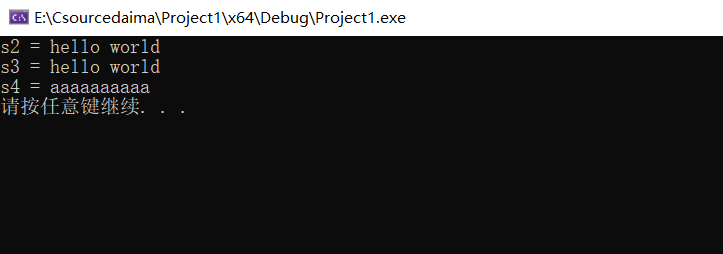
总结:string的多种构造方式没有可比性,灵活使用即可
3.1.3 string赋值操作
功能描述:
给string字符串进行赋值
赋值的函数原型:
string& operator=(const char* s); //char*类型字符串 赋值给当前的字符串
string& operator=(const string &s); //把字符串s赋给当前的字符串
string& operator=(char c); //字符赋值给当前的字符串
string& assign(const char *s); //把字符串s赋给当前的字符串
string& assign(const char *s, int n); //把字符串s的前n个字符赋给当前的字符串
string& assign(const string &s); //把字符串s赋给当前字符串
string& assign(int n, char c); //用n个字符c赋给当前字符串
#include<iostream>
using namespace std;
#include<string>
//string赋值操作
//string& operator=(const char* s); //char*类型字符串 赋值给当前的字符串
//string& operator=(const string& s); //把字符串s赋给当前的字符串
//string& operator=(char c); //字符赋值给当前的字符串
//string& assign(const char* s); //把字符串s赋给当前的字符串
//string& assign(const char* s, int n); //把字符串s的前n个字符赋给当前的字符串
//string& assign(const string& s); //把字符串s赋给当前字符串
//string& assign(int n, char c); //用n个字符c赋给当前字符串
void test01()
{
string str1;
str1 = "hello world";
cout << "str1 = " << str1 << endl;
string str2;
str2 = str1;
cout << "str2 = " << str2 << endl;
string str3;
str3 = 'a';
cout << "str3 = " << str3 << endl;
string str4;
str4.assign("hello C++");
cout << "str4 = " << str4 << endl;
string str5;
str5.assign("hello C++", 5);
cout << "str5 = " << str5 << endl;
string str6;
str6.assign(str5);
cout << "str6 = " << str6 << endl;
string str7;
str7.assign(10, 'w');
cout << "str7 = " << str7 << endl;
}
int main()
{
test01();
system("pause");
return 0;
}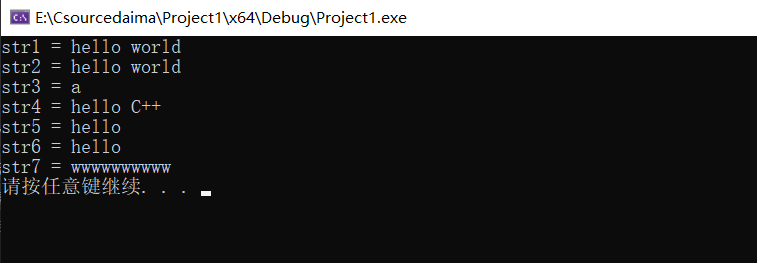
总结:
string的赋值方式很多,operator= 这种方式是比较实用的
3.1.4 string字符串拼接
功能描述:
实现在字符串末尾拼接字符串
函数原型:
string& operator+=(const char* str); //重载+=操作符
string& operator+=(const char c); //重载+=操作符
string& operator+=(const string& str); //重载+=操作符
string& append(const char *s); //把字符串s连接到当前字符串结尾
string& append(const char *s, int n); //把字符串s的前n个字符连接到当前字符串结尾
string& append(const string &s); //同operator+=(const string& str)
string& append(const string &s, int pos, int n);//字符串s中从pos开始的n个字符连接到字符串结尾
#include<iostream>
using namespace std;
#include<string>
//字符串拼接的操作
//string & operator+=(const char* str); //重载+=操作符
//string& operator+=(const char c); //重载+=操作符
//string& operator+=(const string& str); //重载+=操作符
//string& append(const char* s); //把字符串s连接到当前字符串结尾
//string& append(const char* s, int n); //把字符串s的前n个字符连接到当前字符串结尾
//string& append(const string& s); //同operator+=(const string& str)
//string& append(const string& s, int pos, int n);//字符串s中从pos开始的n个字符连接到字符串结尾
void test01()
{
string str1 = "我";
str1 += "爱玩游戏";
cout << "str1 = " << str1 << endl;
str1 += ':';
cout << "str1 = " << str1 << endl;
string str2 = "LOL DNF";
str1 += str2;
cout << "str1 = " << str1 << endl;
string str3 = "I ";
str3.append("love ");
cout << "str3 = " << str3 << endl;
str3.append("game abcde", 4);
cout << "str3 = " << str3 << endl;
/*str3.append(str2);
cout << "str3 = " << str3 << endl*/;
str3.append(str2, 4, 3); //只截取DNF,参数2 从哪个位置开始截取,参数3,截取个数
cout << "str3 = " << str3 << endl;
}
int main()
{
test01();
system("pause");
return 0;
}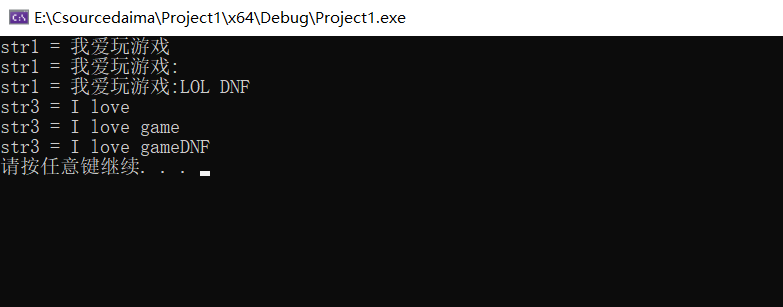
总结:字符串拼接的重载版本很多,初学阶段记住几种即可
3.1.5 string查找和替换
功能描述:
查找:查找指定字符串是否存在
替换:在指定的位置替换字符串
函数原型:
int find(const string& str, int pos = 0) const; //查找str第一次出现位置,从pos开始查找
int find(const char* s, int pos = 0) const; //查找s第一次出现位置,从pos开始查找
int find(const char* s, int pos, int n) const; //从pos位置查找s的前n个字符第一次位置
int find(const char c, int pos = 0) const; //查找字符c第一次出现位置
int rfind(const string& str, int pos = npos) const; //查找str最后一次位置,从pos开始查找
int rfind(const char* s, int pos = npos) const; //查找s最后一次出现位置,从pos开始查找
int rfind(const char* s, int pos, int n) const; //从pos查找s的前n个字符最后一次位置
int rfind(const char c, int pos = 0) const; //查找字符c最后一次出现位置
string& replace(int pos, int n, const string& str); //替换从pos开始n个字符为字符串str
string& replace(int pos, int n,const char* s); //替换从pos开始的n个字符为字符串s
#include<iostream>
using namespace std;
#include<string>
//字符串查找和替换
//1.查找
void test01()
{
string str1 = "abcdefgde";
int pos = str1.find("de");
if (pos == -1)
{
cout << "未找到字符串" << endl;
}
else
{
cout << "找到字符串,pos = " << pos << endl; // pos = 3
}
//rfind 和find的区别
//rfind从右往左查找 find从左往右查找
pos = str1.rfind("de");
cout << "pos = " << pos << endl; // pos = 7
}
//替换
void test02()
{
string str1 = "abcdefg";
//从1号位置起3个字符 替换为"1111"
str1.replace(1, 3, "1111");
cout << "str1 = " << str1 << endl;
}
int main()
{
//test01();
test02(); //a1111efg
system("pause");
return 0;
}总结:
find查找是从左往后,rfind从右往左
find找到字符串后返回查找的第一个字符位置,找不到返回-1
replace在替换时,要指定从哪个位置起,多少个字符,替换成什么样的字符串
3.1.6 string字符串比较
功能描述:
字符串之间的比较
比较方式:
字符串比较是按字符的ASCII码进行对比
= 返回 0
> 返回 1
< 返回 -1
函数原型:
int compare(const string &s) const; //与字符串s比较
#include<iostream>
using namespace std;
#include<string>
//字符串比较操作
void test01()
{
string str1 = "hello";
string str2 = "xello";
if (str1.compare(str2) == 0)
{
cout << "str1等于str2" << endl;
}
else if (str1.compare(str2) > 0)
{
cout << "str1大于str2" << endl;
}
else
{
cout << "str1小于str2" << endl;
}
}
int main()
{
test01();
system("pause");
return 0;
}总结:字符串对比主要是用于比较两个字符串是否相等,判断谁大谁小的意义并不是很大
3.1.7 string字符存取
string中单个字符存取方式有两种
char& operator[](int n); //通过[]方式取字符
char& at(int n); //通过at方法获取字符
int compare(const char *s) const; //与字符串s比较
#include<iostream>
using namespace std;
#include<string>
//string 字符存取
void test01()
{
string str = "hello";
//cout << "str = " << str << endl;
//1.通过[]访问单个字符
for(int i = 0; i < str.size(); i++)
{
cout << str[i] << " ";
}
cout << endl;
//2.通过at方式访问单个字符
for (int i = 0; i < str.size(); i++)
{
cout << str.at(i) << " ";
}
cout << endl;
//修改单个字符
str[0] = 'x';
cout << "str = " << str << endl;
str.at(1) = 'x';
cout << "str = " << str << endl;
}
int main()
{
test01();
system("pause");
return 0;
}总结:string字符串中单个字符存取有两种方式,利用 [ ] 或 at
3.1.8 string插入和删除
功能描述:
对string字符串进行插入和删除字符操作
函数原型:
string& insert(int pos, const char* s); //插入字符串
string& insert(int pos, const string& str); //插入字符串
string& insert(int pos, int n, char c); //在指定位置插入n个字符c
string& erase(int pos, int n = npos); //删除从Pos开始的n个字符
#include<iostream>
using namespace std;
#include<string>
//字符串的插入和删除
void test01()
{
string str = "hello";
//插入
str.insert(1, "111");
cout << "str = " << str << endl; //h111ello
//删除
str.erase(1, 3);
cout << "str = " << str << endl; //hello
}
int main()
{
test01();
system("pause");
return 0;
}**总结:**插入和删除的起始下标都是从0开始
3.1.9 string子串
功能描述:
从字符串中获取想要的子串
函数原型:
string substr(int pos = 0, int n = npos) const; //返回由pos开始的n个字符组成的字符串
#include<iostream>
using namespace std;
#include<string>
//string求子串
void test01()
{
string str = "abcdef";
string subStr = str.substr(1, 3);
cout << "subStr = " << subStr << endl; //bcd
}
//实用操作
void test02()
{
string email = "zhangsan@sina.com";
//从邮件中获取用户名信息
int pos = email.find("@");
cout << pos << endl;
string usrName = email.substr(0, pos);
cout << "usrName = " << usrName << endl; //zhangsan
}
int main()
{
//test01();
test02();
system("pause");
return 0;
}**总结:**灵活的运用求子串功能,可以在实际开发中获取有效的信息
3.2 vector容器
3.2.1 vector基本概念
功能:
vector数据结构和数组非常相似,也称为单端数组
vector与普通数组区别:
不同之处在于数组是静态空间,而vector可以动态扩展
动态扩展:
并不是在原空间之后续接新空间,而是找更大的内存空间,然后将原数据拷贝新空间,释放原空间
vector容器的迭代器是支持随机访问的迭代器
3.2.2 vector构造函数
功能描述:
创建vector容器
函数原型:
vector<T> v; //采用模板实现类实现,默认构造函数
vector(v.begin(), v.end()); //将v[begin(), end())区间中的元素拷贝给本身。
vector(n, elem); //构造函数将n个elem拷贝给本身。
vector(const vector &vec); //拷贝构造函数。
#include<iostream>
using namespace std;
#include<vector>
void printVector(vector<int>&v)
{
for (vector<int>::iterator it = v.begin(); it != v.end(); it++)
{
cout << *it << " ";
}
cout << endl;
}
//vector容器的构造
void test01()
{
vector<int>v1; //默认构造 无参构造
for (int i = 0; i < 10; i++)
{
v1.push_back(i);
}
printVector(v1);
//通过区间的方式进行构造
vector<int>v2(v1.begin(), v1.end());
printVector(v2);
//n个elem方式构造
vector<int>v3(10, 100);
printVector(v3);
//拷贝构造
vector<int>v4(v3);
printVector(v4);
}
int main()
{
test01();
system("pause");
return 0;
}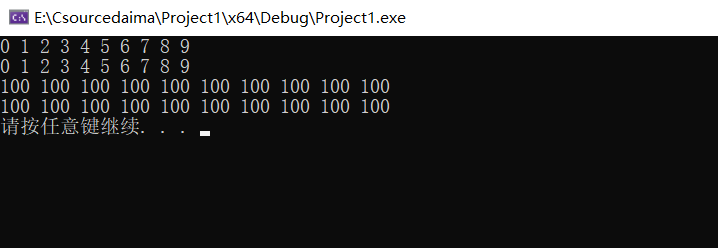
**总结:**vector的多种构造方式没有可比性,灵活使用即可
3.2.3 vector赋值操作
功能描述:
给vector容器进行赋值
函数原型:
vector& operator=(const vector &vec);//重载等号操作符
assign(beg, end); //将[beg, end)区间中的数据拷贝赋值给本身。
assign(n, elem); //将n个elem拷贝赋值给本身。
#include<iostream>
using namespace std;
#include<vector>
void printVector(vector<int>& v)
{
for (vector<int>::iterator it = v.begin(); it != v.end(); it++)
{
cout << *it << " ";
}
cout << endl;
}
//vector的赋值
void test01()
{
vector<int>v1;
for (int i = 0; i < 10; i++)
{
v1.push_back(i);
}
printVector(v1);
//赋值 operator=
vector<int>v2;
v2 = v1;
printVector(v2);
//assign
vector<int>v3;
v3.assign(v1.begin(), v1.end());
printVector(v3);
//n个elem 方式赋值
vector<int>v4;
v4.assign(10, 100);
printVector(v4);
}
int main()
{
test01();
system("pause");
return 0;
}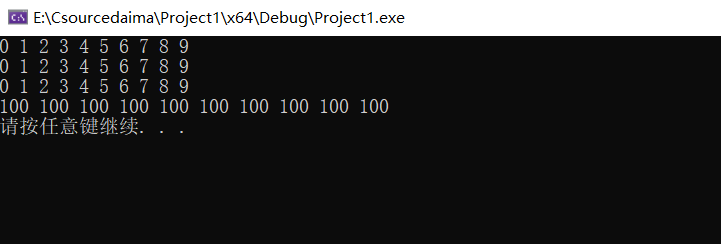
总结: vector赋值方式比较简单,使用operator=,或者assign都可以
3.2.4 vector容量和大小
功能描述:
对vector容器的容量和大小操作
函数原型:
empty(); //判断容器是否为空
capacity(); //容器的容量
size(); //返回容器中元素的个数
resize(int num); //重新指定容器的长度为num,若容器变长,则以默认值填充新位置。
//如果容器变短,则末尾超出容器长度的元素被删除。
resize(int num, elem); //重新指定容器的长度为num,若容器变长,则以elem值填充新位置。
//如果容器变短,则末尾超出容器长度的元素被删除
#include<iostream>
using namespace std;
#include<vector>
void printVector(vector<int>& v)
{
for (vector<int>::iterator it = v.begin(); it != v.end(); it++)
{
cout << *it << " ";
}
cout << endl;
}
//vector容器的容量和大小操作
void test01()
{
vector<int>v1;
for (int i = 0; i < 10; i++)
{
v1.push_back(i);
}
printVector(v1);
if (v1.empty()) //为真 代表容器为空
{
cout << "v1为空" << endl;
}
else
{
cout << "v1不为空" << endl;
cout << "v1的容量为:" << v1.capacity() << endl;
cout << "v1的大小为:" << v1.size() << endl;
}
//重新制定大小
v1.resize(15,100); //利用重载的版本,可以指定默认填充值,参数2
printVector(v1); //如果重新指定的过长,默认用0填充新的位置
v1.resize(5);
printVector(v1); //如果重新指定的比原来短了,超出部分会删掉
}
int main()
{
test01();
system("pause");
return 0;
}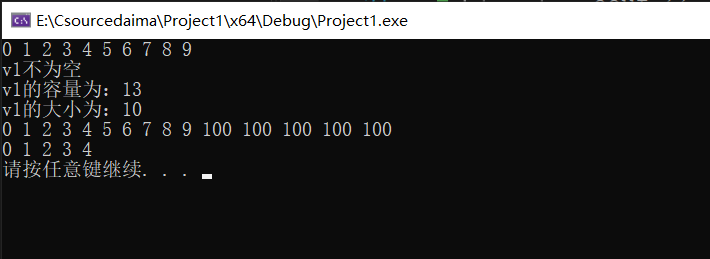
总结:
判断是否为空 — empty
返回元素个数 — size
返回容器容量 — capacity
重新指定大小 — resize
3.2.5 vector插入和删除
功能描述:
对vector容器进行插入、删除操作
函数原型:
push_back(ele); //尾部插入元素ele
pop_back(); //删除最后一个元素
insert(const_iterator pos, ele); //迭代器指向位置pos插入元素ele
insert(const_iterator pos, int count,ele);//迭代器指向位置pos插入count个元素ele
erase(const_iterator pos); //删除迭代器指向的元素
erase(const_iterator start, const_iterator end);//删除迭代器从start到end之间的元素
clear(); //删除容器中所有元素
#include<iostream>
using namespace std;
#include<vector>
void printVector(vector<int>& v)
{
for (vector<int>::iterator it = v.begin(); it != v.end(); it++)
{
cout << *it << " ";
}
cout << endl;
}
//插入和删除
//函数原型:
//push_back(ele); //尾部插入元素ele
//pop_back(); //删除最后一个元素
//insert(const_iterator pos, ele); //迭代器指向位置pos插入元素ele
//insert(const_iterator pos, int count, ele); //迭代器指向位置pos插入count个元素ele
//erase(const_iterator pos); //删除迭代器指向的元素
//erase(const_iterator start, const_iterator end); //删除迭代器从start到end之间的元素
//clear(); //删除容器中所有元素
void test01()
{
vector<int>v1;
//尾插
v1.push_back(10);
v1.push_back(20);
v1.push_back(30);
v1.push_back(40);
v1.push_back(50);
//遍历
printVector(v1);
//尾删
v1.pop_back();
printVector(v1);
//插入 第一个参数是迭代器
v1.insert(v1.begin(), 100);
printVector(v1);
v1.insert(v1.begin(), 2, 1000);
printVector(v1);
//删除 参数也是迭代器
v1.erase(v1.begin());
printVector(v1);
//清空
v1.clear();
//v1.erase(v1.begin(), v1.end());
printVector(v1);
}
int main()
{
test01();
system("pause");
return 0;
}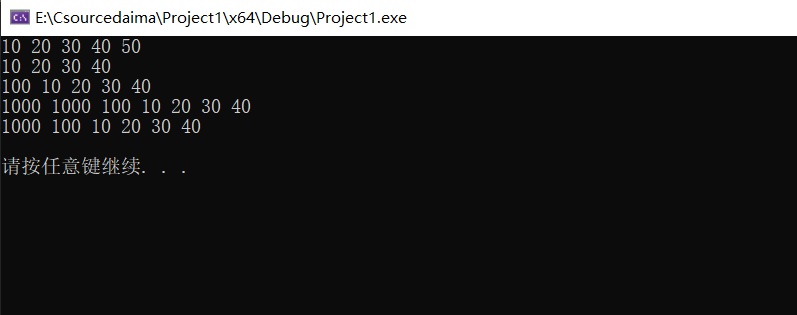
总结:
尾插 — push_back
尾删 — pop_back
插入 — insert (位置迭代器)
删除 — erase (位置迭代器)
清空 — clear
3.2.6 vector数据存取
功能描述:
对vector中的数据的存取操作
函数原型:
at(int idx); //返回索引idx所指的数据
operator[]; //返回索引idx所指的数据
front(); //返回容器中第一个数据元素
back(); //返回容器中最后一个数据元素
#include<iostream>
using namespace std;
#include<vector>
//vector容器 数据存取
void test01()
{
vector<int>v1;
for (int i = 0; i < 10; i++)
{
v1.push_back(i);
}
//利用[]的方式访问数组中的元素
for (int i = 0; i < v1.size(); i++)
{
cout << v1[i] << " ";
}
cout << endl;
//利用at方式访问元素
for (int i = 0; i < v1.size(); i++)
{
cout << v1.at(i) << " ";
}
cout << endl;
//获取第一个元素
cout << "第一个元素为:" << v1.front() << endl;
//获取最后一个元素
cout << "最后一个元素为:" << v1.back() << endl;
}
int main()
{
test01();
system("pause");
return 0;
}总结:
除了用迭代器获取vector容器中元素,[ ]和at也可以
front返回容器第一个元素
back返回容器最后一个元素
3.2.7 vector互换容器
功能描述:
实现两个容器内元素进行互换
函数原型:
swap(vec); // 将vec与本身的元素互换
#include<iostream>
using namespace std;
#include<vector>
//vector容器互换
void printVector(vector<int>& v)
{
for (vector<int>::iterator it = v.begin(); it != v.end(); it++)
{
cout << *it << " ";
}
cout << endl;
}
//1.基本使用
void test01()
{
vector<int>v1;
for (int i = 0; i < 10; i++)
{
v1.push_back(i);
}
cout << "交换前:" << endl;
printVector(v1);
vector<int>v2;
for (int i = 10; i > 0; i--)
{
v2.push_back(i);
}
printVector(v2);
cout << "交换后:" << endl;
v1.swap(v2);
printVector(v1);
printVector(v2);
}
//2.实际用途
//巧用swap可以收缩内存空间
void test02()
{
vector<int>v;
for (int i = 0; i < 100000; i++)
{
v.push_back(i);
}
cout << "v的容量为:" << v.capacity() << endl;
cout << "v的大小为:" << v.size() << endl;
v.resize(3); //重新指定大小
cout << "v的容量为:" << v.capacity() << endl;
cout << "v的大小为:" << v.size() << endl;
//巧用swap收缩内存
vector<int>(v).swap(v);
cout << "v的容量为:" << v.capacity() << endl;
cout << "v的大小为:" << v.size() << endl;
}
int main()
{
//test01();
test02();
system("pause");
return 0;
}总结:swap可以使两个容器互换,可以达到实用的收缩内存效果
3.2.8 vector预留空间
功能描述:
减少vector在动态扩展容量时的扩展次数
函数原型:
reserve(int len);//容器预留len个元素长度,预留位置不初始化,元素不可访问。
#include<iostream>
using namespace std;
#include<vector>
//vector容器 预留空间
void test01()
{
vector<int>v;
//利用reserve预留空间
v.reserve(100000);
int num = 0; //统计开辟次数
int* p = NULL;
for (int i = 0; i < 100000; i++)
{
v.push_back(i);
if (p != &v[0])
{
p = &v[0];
num++;
}
}
cout << "num = " << num << endl;
}
int main()
{
test01();
system("pause");
return 0;
}总结:如果数据量较大,可以一开始利用reserve预留空间
3.3 deque容器
3.3.1 deque容器基本概念
功能:
双端数组,可以对头端进行插入删除操作
deque与vector区别:
vector对于头部的插入删除效率低,数据量越大,效率越低
deque相对而言,对头部的插入删除速度回比vector快
vector访问元素时的速度会比deque快,这和两者内部实现有关
deque内部工作原理:
deque内部有个中控器,维护每段缓冲区中的内容,缓冲区中存放真实数据
中控器维护的是每个缓冲区的地址,使得使用deque时像一片连续的内存空间
deque容器的迭代器也是支持随机访问的
3.3.2 deque构造函数
功能描述:
deque容器构造
函数原型:
deque<T> deqT; //默认构造形式
deque(beg, end); //构造函数将[beg, end)区间中的元素拷贝给本身。
deque(n, elem); //构造函数将n个elem拷贝给本身。
deque(const deque &deq); //拷贝构造函数
#include<iostream>
using namespace std;
#include<deque>
void printDeque(const deque<int>& d)
{
for (deque<int>::const_iterator it = d.begin(); it != d.end(); it++)
{
//*it = 100; 容器中的数据不可以修改
cout << *it << " ";
}
cout << endl;
}
//deque 构造函数
void test01()
{
deque<int>d1;
for (int i = 0; i < 10; i++)
{
d1.push_back(i);
}
printDeque(d1);
deque<int>d2(d1.begin(), d1.end());
printDeque(d2);
deque<int>d3(10, 100);
printDeque(d3);
deque<int>d4(d3);
printDeque(d4);
}
int main()
{
test01();
system("pause");
return 0;
}3.3.3 deque赋值操作
功能描述:
给deque容器进行赋值
函数原型:
deque& operator=(const deque &deq); //重载等号操作符
assign(beg, end); //将[beg, end)区间中的数据拷贝赋值给本身。
assign(n, elem); //将n个elem拷贝赋值给本身。
#include<iostream>
using namespace std;
#include<deque>
void printDeque(const deque<int>& d)
{
for (deque<int>::const_iterator it = d.begin(); it != d.end(); it++)
{
//*it = 100; 容器中的数据不可以修改
cout << *it << " ";
}
cout << endl;
}
//deque容器的赋值操作
void test01()
{
deque<int>d1;
for (int i = 0; i < 10; i++)
{
d1.push_back(i);
}
printDeque(d1);
// operator= 赋值
deque<int>d2;
d2 = d1;
printDeque(d2);
//assign赋值
deque<int>d3;
d3.assign(d1.begin(),d1.end());
printDeque(d3);
deque<int>d4;
d4.assign(10, 100);
printDeque(d4);
}
int main()
{
test01();
system("pause");
return 0;
}总结:deque赋值操作也与vector相同,需熟练掌握
3.3.4 deque大小操作
功能描述:
对deque容器的大小进行操作
函数原型:
deque.empty(); //判断容器是否为空
deque.size(); //返回容器中元素的个数
deque.resize(num); //重新指定容器的长度为num,若容器变长,则以默认值填充新位置。
//如果容器变短,则末尾超出容器长度的元素被删除。
deque.resize(num, elem); //重新指定容器的长度为num,若容器变长,则以elem值填充新位置。
//如果容器变短,则末尾超出容器长度的元素被删除。
#include<iostream>
using namespace std;
#include<deque>
void printDeque(const deque<int>& d)
{
for (deque<int>::const_iterator it = d.begin(); it != d.end(); it++)
{
//*it = 100; 容器中的数据不可以修改
cout << *it << " ";
}
cout << endl;
}
//deque容器大小操作
void test01()
{
deque<int>d1;
for (int i = 0; i < 10; i++)
{
d1.push_back(i);
}
printDeque(d1);
if (d1.empty())
{
cout << "d1为空" << endl;
}
else
{
cout << "d1不为空" << endl;
cout << "d1的大小为:" << d1.size() << endl;
//deque容器没有容量的概念
}
//重新指定大小
//d1.resize(15);
d1.resize(15,1);
printDeque(d1);
d1.resize(5);
printDeque(d1);
}
int main()
{
test01();
system("pause");
return 0;
}总结:
deque没有容量的概念
判断是否为空 — empty
返回元素个数 — size
重新指定个数 — resize
3.3.5 deque 插入和删除
功能描述:
向deque容器中插入和删除数据
函数原型:
两端插入操作:
push_back(elem); //在容器尾部添加一个数据
push_front(elem); //在容器头部插入一个数据
pop_back(); //删除容器最后一个数据
pop_front(); //删除容器第一个数据
指定位置操作:
insert(pos,elem); //在pos位置插入一个elem元素的拷贝,返回新数据的位置。
insert(pos,n,elem); //在pos位置插入n个elem数据,无返回值。
insert(pos,beg,end); //在pos位置插入[beg,end)区间的数据,无返回值。
clear(); //清空容器的所有数据
erase(beg,end); //删除[beg,end)区间的数据,返回下一个数据的位置。
erase(pos); //删除pos位置的数据,返回下一个数据的位置。
#include<iostream>
using namespace std;
#include<deque>
void printDeque(const deque<int>& d)
{
for (deque<int>::const_iterator it = d.begin(); it != d.end(); it++)
{
//*it = 100; 容器中的数据不可以修改
cout << *it << " ";
}
cout << endl;
}
//deque容器插入和删除
//两端操作
void test01()
{
deque<int>d1;
//尾插
d1.push_back(10);
d1.push_back(20);
//头插
d1.push_front(100);
d1.push_front(200);
printDeque(d1);
//尾删
d1.pop_back();
printDeque(d1);
//头删
d1.pop_front();
printDeque(d1);
}
void test02()
{
deque<int>d1;
d1.push_back(10);
d1.push_back(20);
d1.push_front(100);
d1.push_front(200);
printDeque(d1);
//insert插入
d1.insert(d1.begin(), 1000);
printDeque(d1);
d1.insert(d1.begin(),2, 10000);
printDeque(d1);
//按照区间进行插入
deque<int>d2;
d2.push_back(1);
d2.push_back(2);
d2.push_back(3);
d1.insert(d1.begin(), d2.begin(), d2.end());
printDeque(d1);
}
void test03()
{
deque<int>d1;
d1.push_back(10);
d1.push_back(20);
d1.push_front(100);
d1.push_front(200);
//删除
deque<int>::iterator it = d1.begin();
it++;
d1.erase(it);
printDeque(d1);
//按照区间的方式删除
//d1.erase(d1.begin(), d1.end());
//清空
d1.clear();
printDeque(d1);
}
int main()
{
//test01();
//test02();
test03();
system("pause");
return 0;
}总结:
插入和删除提供的位置是迭代器!
尾插 — push_back
尾删 — pop_back
头插 — push_front
头删 — pop_front
3.3.6 deque 数据存取
功能描述:
对deque 中的数据的存取操作
函数原型:
at(int idx); //返回索引idx所指的数据
operator[]; //返回索引idx所指的数据
front(); //返回容器中第一个数据元素
back(); //返回容器中最后一个数据元素
#include<iostream>
using namespace std;
#include<deque>
//deque容器数据存取
void test01()
{
deque<int>d;
d.push_back(10);
d.push_back(20);
d.push_back(30);
d.push_front(100);
d.push_front(200);
d.push_front(300);
//1.通过[]方式访问元素
for (int i = 0; i < d.size(); i++)
{
cout << d[i] << " ";
}
cout << endl;
//通过at凡是访问元素
for (int i = 0; i < d.size(); i++)
{
cout << d.at(i) << " ";
}
cout << endl;
cout << "第一个元素为:" << d.front() << endl;
cout << "最后一个元素为:" << d.back() << endl;
}
int main()
{
test01();
system("pause");
return 0;
}总结:
除了用迭代器获取deque容器中元素,[ ]和at也可以
front返回容器第一个元素
back返回容器最后一个元素
3.3.7 deque 排序
功能描述:
利用算法实现对deque容器进行排序
算法
sort(iterator beg, iterator end) //对beg和end区间内元素进行排序
#include<iostream>
using namespace std;
#include<deque>
#include<algorithm>
void printDeque(const deque<int>& d)
{
for (deque<int>::const_iterator it = d.begin(); it != d.end(); it++)
{
cout << *it << " ";
}
cout << endl;
}
//deque容器排序
void test01()
{
deque<int>d;
d.push_back(10);
d.push_back(20);
d.push_back(30);
d.push_front(100);
d.push_front(200);
d.push_front(300);
//300 200 100 10 20 30
printDeque(d);
//排序 默认排序规则是从小到大 升序
//对于支持随机访问的迭代器的容器,都可以利用sort算法直接对其进行排序
//vector也可以利用sort进行排序
sort(d.begin(), d.end());
cout << "排序后:" << endl;
printDeque(d);
}
int main()
{
test01();
system("pause");
return 0;
}总结:sort算法非常实用,使用时包含头文件 algorithm即可
3.4 案例-评委打分
3.4.1 案例描述
有5名选手:选手ABCDE,10个评委分别对每一名选手打分,去除最高分,去除评委中最低分,取平均分。
3.4.2 实现步骤
创建五名选手,放到vector中
遍历vector容器,取出来每一个选手,执行for循环,可以把10个评分打分存到deque容器中
sort算法对deque容器中分数排序,去除最高和最低分
deque容器遍历一遍,累加总分
获取平均分
#include<iostream>
using namespace std;
#include<string>
#include<vector>
#include<deque>
#include<algorithm>
#include<ctime>
//有5名选手:选手ABCDE,10个评委分别对每一名选手打分,
//去除最高分,去除评委中最低分,取平均分。
//选手类
class Person
{
public:
Person(string name, int score)
{
this->m_Name = name;
this->m_Score = score;
}
string m_Name;
int m_Score;
};
void createPerson(vector<Person>& v)
{
string nameSeed = "ABCDE";
for (int i = 0; i < 5; i++)
{
string name = "选手";
name += nameSeed[i];
int score = 0;
Person p(name, score);
//将创建的Person对象 放入到容器中
v.push_back(p);
}
}
void setScore(vector<Person>& v)
{
for (vector<Person>::iterator it = v.begin(); it != v.end(); it++)
{
//将评委的分数放到deque容器中
deque<int>d;
for (int i = 0; i < 10; i++)
{
int score = rand() % 41 + 60; // 60~100
d.push_back(score);
}
//cout << "选手:" << it->m_Name << "打分:" << endl;
//for (deque<int>::iterator dit = d.begin(); dit != d.end(); dit++)
//{
// cout << *dit << " "; //累加每个评委的分数
//}
//cout << endl;
//先排序
sort(d.begin(), d.end());
//去除最高分和最低分
d.pop_front();
d.pop_back();
//取平均分
int sum = 0;
for (deque<int>::iterator dit = d.begin(); dit != d.end(); dit++)
{
sum += *dit; //累加每个评委的分数
}
int avg = sum / d.size();
//将平均分赋值给选手
it->m_Score = avg;
}
}
void showScore(vector<Person>& v)
{
for (vector<Person>::iterator it = v.begin(); it != v.end(); it++)
{
cout << "姓名:" << it->m_Name << " 平均分:" << it->m_Score << endl;
}
}
int main()
{
//随机数种子
srand((unsigned int)time(NULL));
//1.创建5名选手
vector<Person>v; //存放选手的容器
createPerson(v);
//测试
/*for (vector<Person>::iterator it = v.begin(); it != v.end();it++)
{
cout << "姓名:" << (*it).m_Name << " 分数:" << (*it).m_Score << endl;
}
cout << endl;*/
//2.给5名选手打分
setScore(v);
//3.显示最后得分
showScore(v);
system("pause");
return 0;
}3.5 stack容器
3.5.1 stack 基本概念
概念:stack是一种先进后出(First In Last Out,FILO)的数据结构,它只有一个出口
栈中只有顶端的元素才可以被外界使用,因此栈不允许有遍历行为
栈中进入数据称为 — 入栈 push
栈中弹出数据称为 — 出栈 pop
3.5.2 stack 常用接口
功能描述:栈容器常用的对外接口
构造函数:
stack<T> stk; //stack采用模板类实现, stack对象的默认构造形式
stack(const stack &stk); //拷贝构造函数
赋值操作:
stack& operator=(const stack &stk); //重载等号操作符
数据存取:
push(elem); //向栈顶添加元素
pop(); //从栈顶移除第一个元素
top(); //返回栈顶元素
大小操作:
empty(); //判断堆栈是否为空
size(); //返回栈的大小
#include<iostream>
using namespace std;
#include<stack>
//栈stack容器
void test01()
{
//特点,符合先进后出数据结构
stack<int>s;
//入栈
s.push(10);
s.push(20);
s.push(30);
s.push(40);
cout << "栈的大小为:" << s.size() << endl;
//只要栈不为空,查看栈顶,并且执行出栈操作
while (!s.empty())
{
//查看栈顶元素
cout << "栈顶元素:" << s.top() << endl;
//出栈
s.pop();
}
cout << "栈的大小为:" << s.size() << endl;
}
int main()
{
test01();
system("pause");
return 0;
}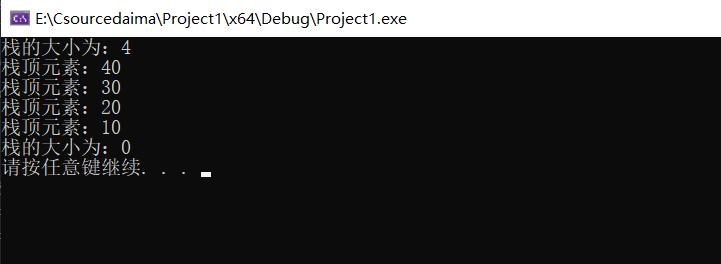
入栈 — push
出栈 — pop
返回栈顶 — top
判断栈是否为空 — empty
返回栈大小 — size
3.6 queue 容器
3.6.1 queue 基本概念
概念:Queue是一种先进先出(First In First Out,FIFO)的数据结构,它有两个出口
队列容器允许从一端新增元素,从另一端移除元素
队列中只有队头和队尾才可以被外界使用,因此队列不允许有遍历行为
队列中进数据称为 — 入队 push
队列中出数据称为 — 出队 pop
3.6.2 queue 常用接口
功能描述:栈容器常用的对外接口
构造函数:
queue<T> que; //queue采用模板类实现,queue对象的默认构造形式
queue(const queue &que); //拷贝构造函数
赋值操作:
queue& operator=(const queue &que); //重载等号操作符
数据存取:
push(elem); //往队尾添加元素
pop(); //从队头移除第一个元素
back(); //返回最后一个元素
front(); //返回第一个元素
大小操作:
empty(); //判断堆栈是否为空
size(); //返回栈的大小
#include<iostream>
using namespace std;
#include<queue>
#include<string>
//队列
class Person
{
public:
Person(string name, int age)
{
this->m_Name = name;
this->m_Age = age;
}
string m_Name;
int m_Age;
};
void test01()
{
queue<Person>q;
Person p1("唐僧", 30);
Person p2("孙悟空", 1000);
Person p3("猪八戒", 900);
Person p4("沙僧", 800);
//入队
q.push(p1);
q.push(p2);
q.push(p3);
q.push(p4);
cout << "队列的大小为:" << q.size() << endl;
//判断 只要队列不为空,查看队头,查看队尾,出队
while (!q.empty())
{
//查看队头
cout << "队头元素----姓名:" << q.front().m_Name << "年龄:" << q.front().m_Age << endl;
cout << "队尾元素----姓名:" << q.back().m_Name << "年龄:" << q.back().m_Age << endl;
//出队
q.pop();
}
cout << "队列的大小为:" << q.size() << endl;
}
int main()
{
test01();
system("pause");
return 0;
}总结:
入队 — push
出队 — pop
返回队头元素 — front
返回队尾元素 — back
判断队是否为空 — empty
返回队列大小 — size
3.7 list容器
3.7.1 list基本概念
**功能:**将数据进行链式存储
链表(list)是一种物理存储单元上非连续的存储结构,数据元素的逻辑顺序是通过链表中的指针链接实现的
链表的组成:链表由一系列结点组成
结点的组成:一个是存储数据元素的数据域,另一个是存储下一个结点地址的指针域
STL中的链表是一个双向循环链表
由于链表的存储方式并不是连续的内存空间,因此链表list中的迭代器只支持前移和后移,属于双向迭代器
list的优点:
采用动态存储分配,不会造成内存浪费和溢出
链表执行插入和删除操作十分方便,修改指针即可,不需要移动大量元素
list的缺点:
链表灵活,但是空间(指针域) 和 时间(遍历)额外耗费较大
List有一个重要的性质,插入操作和删除操作都不会造成原有list迭代器的失效,这在vector是不成立的。
总结:STL中List和vector是两个最常被使用的容器,各有优缺点
3.7.2 list构造函数
功能描述:
创建list容器
函数原型:
list<T> lst; //list采用采用模板类实现,对象的默认构造形式:
list(beg,end); //构造函数将[beg, end)区间中的元素拷贝给本身。
list(n,elem); //构造函数将n个elem拷贝给本身。
list(const list &lst); //拷贝构造函数。
#include<iostream>
using namespace std;
#include<list>
//list容器的构造函数
void printList(const list<int>& L)
{
for (list<int>::const_iterator it = L.begin(); it != L.end(); it++)
{
cout << *it << " ";
}
cout << endl;
}
void test01()
{
//创建list容器
list<int>L1;
L1.push_back(10);
L1.push_back(20);
L1.push_back(30);
L1.push_back(40);
L1.push_back(50);
//遍历容器
printList(L1);
//按照区间的方式进行构造
list<int>L2(L1.begin(), L1.end());
printList(L2);
//拷贝构造
list<int>L3(L2);
printList(L3);
//n个elem
list<int>L4(10, 1000);
printList(L4);
}
int main()
{
test01();
system("pause");
return 0;
}总结:list构造方式同其他几个STL常用容器,熟练掌握即可
3.7.3 list 赋值和交换
功能描述:
给list容器进行赋值,以及交换list容器
函数原型:
assign(beg, end); //将[beg, end)区间中的数据拷贝赋值给本身。
assign(n, elem); //将n个elem拷贝赋值给本身。
list& operator=(const list &lst); //重载等号操作符
swap(lst); //将lst与本身的元素互换。
#include<iostream>
using namespace std;
#include<list>
//list容器的赋值和交换
void printList(const list<int>& L)
{
for (list<int>::const_iterator it = L.begin(); it != L.end(); it++)
{
cout << *it << " ";
}
cout << endl;
}
void test01()
{
list<int>L1;
L1.push_back(10);
L1.push_back(20);
L1.push_back(30);
L1.push_back(40);
printList(L1);
list<int>L2;
L2 = L1;
printList(L2);
list<int>L3;
L3.assign(L2.begin(), L2.end());
printList(L3);
list<int>L4;
L4.assign(10, 100);
printList(L4);
}
//交换
void test02()
{
list<int>L1;
L1.push_back(10);
L1.push_back(20);
L1.push_back(30);
L1.push_back(40);
list<int>L2;
L2.assign(10, 100);
cout << "交换前:" << endl;
printList(L1);
printList(L2);
L1.swap(L2);
cout << "交换后:" << endl;
printList(L1);
printList(L2);
}
int main()
{
//test01();
test02();
system("pause");
return 0;
}总结:list赋值和交换操作能够灵活运用即可
3.7.4 list 大小操作
功能描述:
对list容器的大小进行操作
函数原型:
size(); //返回容器中元素的个数
empty(); //判断容器是否为空
resize(num); //重新指定容器的长度为num,若容器变长,则以默认值填充新位置。
//如果容器变短,则末尾超出容器长度的元素被删除。
resize(num, elem); //重新指定容器的长度为num,若容器变长,则以elem值填充新位置。
//如果容器变短,则末尾超出容器长度的元素被删除。
#include<iostream>
using namespace std;
#include<list>
//list容器大小的操作
void printList(const list<int>& L)
{
for (list<int>::const_iterator it = L.begin(); it != L.end(); it++)
{
cout << *it << " ";
}
cout << endl;
}
void test01()
{
list<int>L1;
L1.push_back(10);
L1.push_back(20);
L1.push_back(30);
L1.push_back(40);
printList(L1);
//判断容器是否为空
if (L1.empty())
{
cout << "L1为空" << endl;
}
else
{
cout << "L1不为空" << endl;
cout << "L1的元素个数为:" << L1.size() << endl;
}
//重新指定大小
//L1.resize(10);
//printList(L1);
L1.resize(10, 100);
printList(L1);
L1.resize(3);
printList(L1);
}
int main()
{
test01();
system("pause");
return 0;
}总结:
判断是否为空 — empty
返回元素个数 — size
重新指定个数 — resize
3.7.5 list 插入和删除
功能描述:
对list容器进行数据的插入和删除
函数原型:
push_back(elem);//在容器尾部加入一个元素
pop_back();//删除容器中最后一个元素
push_front(elem);//在容器开头插入一个元素
pop_front();//从容器开头移除第一个元素
insert(pos,elem);//在pos位置插elem元素的拷贝,返回新数据的位置。
insert(pos,n,elem);//在pos位置插入n个elem数据,无返回值。
insert(pos,beg,end);//在pos位置插入[beg,end)区间的数据,无返回值。
clear();//移除容器的所有数据
erase(beg,end);//删除[beg,end)区间的数据,返回下一个数据的位置。
erase(pos);//删除pos位置的数据,返回下一个数据的位置。
remove(elem);//删除容器中所有与elem值匹配的元素。
#include<iostream>
using namespace std;
#include<list>
//list容器插入和删除
void printList(const list<int>& L)
{
for (list<int>::const_iterator it = L.begin(); it != L.end(); it++)
{
cout << *it << " ";
}
cout << endl;
}
void test01()
{
list<int>L;
L.push_back(10);
L.push_back(20);
L.push_back(30);
L.push_front(100);
L.push_front(200);
L.push_front(300);
printList(L);
//尾删
L.pop_back();
printList(L);
//头删
L.pop_front();
printList(L);
//insert插入
list<int>::iterator it = L.begin();
L.insert(++it, 1000);
printList(L);
//删除
it = L.begin();
L.erase(++it);
printList(L);
//移除
L.push_back(10000);
L.push_back(10000);
L.push_back(10000);
L.push_back(10000);
printList(L);
L.remove(10000);
printList(L);
//清空
L.clear();
printList(L);
}
int main()
{
test01();
system("pause");
return 0;
}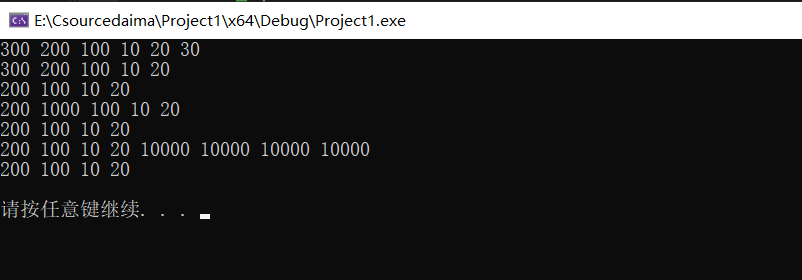
总结:
尾插 — push_back 尾删 — pop_back
头插 — push_front 头删 — pop_front
插入 — insert 删除 — erase
移除 — remove 清空 — clear
3.7.6 list 数据存取
功能描述:
对list容器中数据进行存取
函数原型:
front(); //返回第一个元素。
back(); //返回最后一个元素。
#include<iostream>
using namespace std;
#include<list>
//list容器 数据存取
void test01()
{
list<int>L1;
L1.push_back(10);
L1.push_back(20);
L1.push_back(30);
//L1[0] 不可以用[]的方式访问list容器中的元素
//L1.at(0) 不可以用at方式访问list容器中的元素
//原因list本质是一个链表,不是用连续线性空间存储数据,迭代器也是不支持随机访问的
cout << "第一个元素为:" << L1.front() << endl;
cout << "最后一个元素与为:" << L1.back() << endl;
//迭代器是不支持随机访问的
list<int>::iterator it = L1.begin();
it++; //支持双向
it--;
//it = it + 1; 不支持随机访问
}
int main()
{
test01();
system("pause");
return 0;
}总结:
list容器中不可以通过[]或者at方式访问数据
返回第一个元素 — front
返回最后一个元素 — back
3.7.7 list 反转和排序
功能描述:
将容器中的元素反转,以及将容器中的数据进行排序
函数原型:
reverse(); //反转链表
sort(); //链表排序
#include<iostream>
using namespace std;
#include<list>
#include<algorithm>
//list容器 反转和排序
void printList(const list<int>& L)
{
for (list<int>::const_iterator it = L.begin(); it != L.end(); it++)
{
cout << *it << " ";
}
cout << endl;
}
void test01()
{
//反转
list<int>L1;
L1.push_back(20);
L1.push_back(10);
L1.push_back(50);
L1.push_back(40);
L1.push_back(30);
cout << "反转前" << endl;
printList(L1);
//反转
L1.reverse();
cout << "反转后" << endl;
printList(L1);
}
bool myCompare(int v1,int v2)
{
//降序 就让第一个数 > 第二个数
return v1 > v2;
}
//排序
void test02()
{
list<int>L1;
L1.push_back(20);
L1.push_back(10);
L1.push_back(50);
L1.push_back(40);
L1.push_back(30);
//排序
cout << "排序前" << endl;
printList(L1);
//所有不支持随机访问迭代器的容器,不可以用标准算法
//不支持随机访问迭代器的容器,内部会提供对应的一些算法
//sort(L1.begin(), L1.end());
L1.sort(); //默认排序规则 从小到大 升序
cout << "排序后" << endl;
printList(L1);
L1.sort(myCompare);
printList(L1);
}
int main()
{
//test01();
test02();
system("pause");
return 0;
}案例描述:将Person自定义数据类型进行排序,Person中属性有姓名、年龄、身高
排序规则:按照年龄进行升序,如果年龄相同按照身高进行降序
#include<iostream>
using namespace std;
#include<string>
#include<list>
//list容器排序案例 对于自定义类型来说
//排序规则:按照年龄进行升序,如果年龄相同按照身高进行降序
class Person
{
public:
Person(string name, int age, int height)
{
this->m_Name = name;
this->m_Age = age;
this->m_Height = height;
}
string m_Name;
int m_Age;
int m_Height;
};
//指定排序规则
bool comparePerson(Person &p1,Person &p2)
{
//按照年龄 升序
if (p1.m_Age == p2.m_Age)
{
//年龄相同 按照身高降序排列
return p1.m_Height > p2.m_Height;
}
return p1.m_Age < p2.m_Age;
}
void test01()
{
list<Person>L; //创建容器
//准备数据
Person p1("刘备", 35, 175);
Person p2("曹操", 45, 180);
Person p3("孙权", 40, 170);
Person p4("赵云", 25, 190);
Person p5("张飞", 35, 160);
Person p6("关羽", 35, 200);
//插入数据
L.push_back(p1);
L.push_back(p2);
L.push_back(p3);
L.push_back(p4);
L.push_back(p5);
L.push_back(p6);
for (list<Person>::iterator it = L.begin(); it != L.end(); it++)
{
cout << "姓名:" << (*it).m_Name << "年龄:" << (*it).m_Age << "身高:" << (*it).m_Height << endl;
}
//排序
cout << "-------------------" << endl;
cout << "排序后" << endl;
L.sort(comparePerson);
for (list<Person>::iterator it = L.begin(); it != L.end(); it++)
{
cout << "姓名:" << (*it).m_Name << "年龄:" << (*it).m_Age << "身高:" << (*it).m_Height << endl;
}
}
int main()
{
test01();
system("pause");
return 0;
}总结:
对于自定义数据类型,必须要指定排序规则,否则编译器不知道如何进行排序
高级排序只是在排序规则上再进行一次逻辑规则制定,并不复杂






















 422
422

 被折叠的 条评论
为什么被折叠?
被折叠的 条评论
为什么被折叠?








